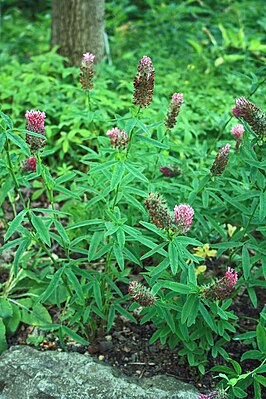Purple clover
| Purple clover | ||||||||||||
|---|---|---|---|---|---|---|---|---|---|---|---|---|

Purple clover ( Trifolium rubens ) |
||||||||||||
| Systematics | ||||||||||||
|
||||||||||||
| Scientific name | ||||||||||||
| Trifolium rubens | ||||||||||||
| L. |
The purple clover ( Trifolium rubens ), also called Foxtail Klee referred to, is a flowering plant in the sub-family of papilionaceous (Faboideae) within the family of the Leguminosae (Fabaceae). It belongs to the Alpestria subsection from the Trifolium section in the genus Klee ( Trifolium ). It is widespread from Central Europe to the Mediterranean and Eastern Europe to the Crimea .
description
Appearance and leaf
The purple clover is a perennial herbaceous plant that usually reaches heights of 20 to 60 centimeters. The stem grows upright and is bare. The leaflets are elongated-lanceolate, about 4 to 6.5 centimeters long, 0.8 to 1.4 centimeters wide, pointed and also mostly glabrous. The bare stipules are up to 8 inches long, lanceolate with a small, serrated edge.
Inflorescence and flower
The flowering time is mainly in the months of June and July. The head-shaped inflorescences are elongated cylindrical shape with a length of 3 to 7 centimeters and a diameter of 2 to 3 centimeters and are often in pairs. They are often covered at the bottom. The hermaphrodite flowers are zygomorphic and five-fold with a double flower envelope . The five sepals are fused into a mostly bare calyx tube, which is provided with 12 to 20 nerves. The shaggy, hairy calyx teeth are of unequal length, the lower teeth being noticeably much longer than the uppermost teeth. The 12 to 15 millimeter long corolla has the typical shape of a butterfly flower and is purple, very rarely white.
Chromosome number
The number of chromosomes is 2n = 16.
Occurrence
The purple clover is widespread from Central Europe to the Mediterranean region to Asia Minor as well as Armenia and Eastern Europe to Crimea . It is a temperate-continental-sub-Mediterranean floral element . The purple clover has its main distribution in the Mediterranean area and southern Europe . In Central Europe it reaches the northern limit of its area and is rarely found there. The area of the purple clover stretches from the northern Spanish mountains over central Italy and Thrace in the south; northwards to northern France , Belgium , Germany to around Kassel, (previously even to Hanover) and Poland ; east to Ukraine . The purple clover thrives in Central Europe mostly in the colline and montane altitudes .
It occurs in Central Europe north of an imaginary line from the Eifel to the Rhön only sporadically west of Fulda; in the low mountain ranges with calcareous rock and in the foothills of the Alps it is rare, but there it often forms smaller, loose stands; it is absent in the low mountain ranges with lime-poor or lime-free rock, as well as in larger areas of the Alpine foothills; it is very rare in the northern Alpine chains, as well as in western Switzerland ; it is rare in the central and southern alps . In Germany , the purple clover is usually rare and mainly native to the Swabian Alb and the central area. According to the 1996 Red List of Endangered Plant Species in Germany, it is considered endangered. The purple clover is rarely found in Austria and is locally endangered. In Switzerland it is generally scattered.
Trifolium rubens colonizes Central Europe in dry bush and sparse dry forest communities. It is a character species of the Geranion sanguinei association, but also occurs in societies of the order Quercetalia pubescentis. It only climbs up to a maximum of 1000 meters in the Alps .
The purple clover thrives best warm, dry, slightly chalky or at least cation rich , loamy or lößhaltigen soils that may be rocky or otherwise profound.
swell
literature
- Henning Haeupler, Thomas Muer: picture atlas of the fern and flowering plants of Germany . Ed .: Federal Agency for Nature Conservation (= The fern and flowering plants of Germany . Volume 2 ). Eugen Ulmer, Stuttgart (Hohenheim) 2000, ISBN 3-8001-3364-4 .
- Wolfgang Adler, Karl Oswald, Raimund Fischer: Excursion flora of Austria . Ed .: Manfred A. Fischer. Eugen Ulmer, Stuttgart / Vienna 1994, ISBN 3-8001-3461-6 .
- Christian Heitz: School and excursion flora for Switzerland. Taking into account the border areas. Identification book for wild growing vascular plants . Founded by August Binz. 18th completely revised and expanded edition. Schwabe & Co., Basel 1986, ISBN 3-7965-0832-4 .
- Erich Oberdorfer : Plant-sociological excursion flora . With the collaboration of Theo Müller. 6th, revised and expanded edition. Eugen Ulmer, Stuttgart (Hohenheim) 1990, ISBN 3-8001-3454-3 .
- Konrad von Weihe (ed.): Illustrated flora. Germany and neighboring areas. Vascular cryptogams and flowering plants . Founded by August Garcke. 23rd edition. Paul Parey, Berlin / Hamburg 1972, ISBN 3-489-68034-0 .
Individual evidence
- ↑ a b Trifolium rubens L., Foxtail clover. In: FloraWeb.de.
- ↑ a b Erich Oberdorfer : Plant-sociological excursion flora for Germany and neighboring areas . 8th edition. Verlag Eugen Ulmer, Stuttgart 2001, ISBN 3-8001-3131-5 . Page 597.
- ↑ a b c d Dietmar Aichele, Heinz-Werner Schwegler: The flowering plants of Central Europe . 2nd Edition. tape 2 : Yew family to butterfly family . Franckh-Kosmos, Stuttgart 2000, ISBN 3-440-08048-X .
- ↑ a b Oskar Sebald, Siegmund Seybold, Georg Philippi (ed.): The fern and flowering plants of Baden-Württemberg. Volume 3: Special part (Spermatophyta, subclass Rosidae): Droseraceae to Fabaceae. Eugen Ulmer, Stuttgart 1992, ISBN 3-8001-3314-8 .
Web links
- Purple clover. In: FloraWeb.de.
- Purple clover . In: BiolFlor, the database of biological-ecological characteristics of the flora of Germany.
- Profile and distribution map for Bavaria . In: Botanical Information Hub of Bavaria .
- Trifolium rubens L. In: Info Flora , the national data and information center for Swiss flora .
- Thomas Meyer: Data sheet with identification key and photos at Flora-de: Flora von Deutschland (old name of the website: Flowers in Swabia )



